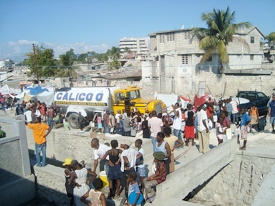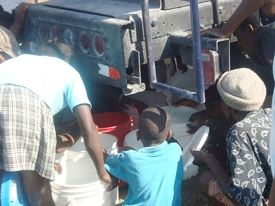For the past few weeks, all of our resources have been devoted to responding to the catastrophic 7.0 earthquake that hit Haiti last month. As you know, much of the pre-existing water system suffered extensive damage during the quake, and tens of thousands in Port-au-Prince remain without a safe, reliable water supply.
Leading disaster response and humanitarian aid organizations including the Red Cross, Mercy Corps, and UNICEF have recognized water as the top priority in saving lives and preventing diseases following the earthquake. In the absence of potable water, there is a danger that earthquake survivors will resort to drinking water sources contaminated by human waste, garbage, or industrial byproducts.

We are currently working with the US military, Globus Relief, Seven Mercies, Arch Chemicals, and other organizations to ship two pallets of chlorinators, nine pallets of chlorine (which will clean up to 200 million gallons of water), and 100 special tanks to Haiti. We thank them for their help.
After the quake, we rented local water tank trucks, filled them and chlorinated their contents, and distributed 90 truckloads—each carrying 3,100 gallons—of safe, potable water to the poorest parts of Port-au-Prince.

Here are some photos of our Haiti Director Dalebrun Esther distributing water to neighborhoods around Port-au-Prince. More of our photos can be seen at After the Earthquake: Progress Report and Photos.
Our local staff has identified 13 intact large water storage tanks, and we are now leasing 23 private reservoirs, which on average can hold 3,000 gallons each. We have negotiated with owners to fill the reservoirs and to distribute chlorinated water to local residents on a daily basis. Most are in Cité Soleil—Haiti’s worst slum.
While it will take time to repair Port-au-Prince’s damaged water systems, International Action is making an initial purchase of 68 larger tanks each with a 2,000-gallon storage capacity to replace those lost. We are also developing a plan for rebuilding and repairing tanks and chlorinators destroyed by the quake, in addition to adding water storage in neighborhoods currently without water tanks. This effort will reach 2 million residents in a period of five years.
Send us your request for a map of Port-au-Prince developed from our data showing water lines, water tanks, and their condition today. The map was made by USAID for the US military and other UN-related groups aiding Haiti. We’ve provided a high-resolution map (PDF, 645KB) for those interested.
